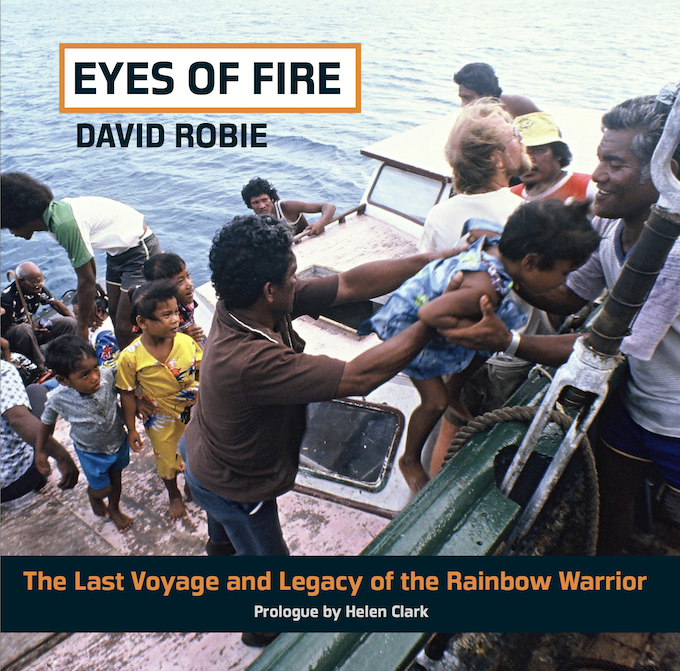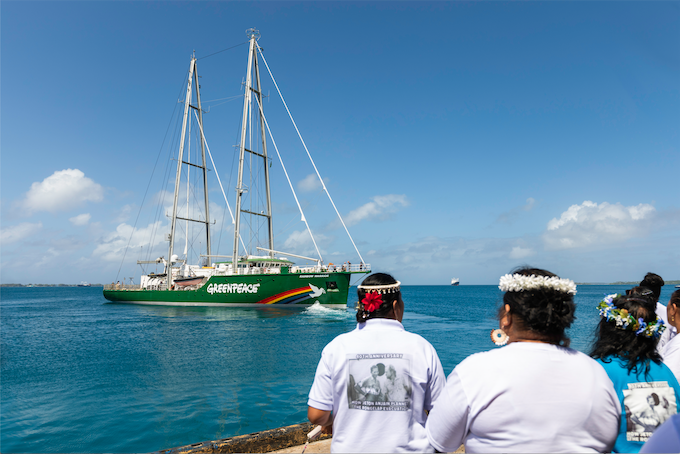COMMENTARY: By Eugene Doyle
Immediately after killing Fernando Pereira and blowing up Greenpeace’s flagship the Rainbow Warrior in Auckland harbour, several of the French agents went on a ski holiday in New Zealand’s South Island to celebrate.
Such was the contempt the French had for the Kiwis and the abilities of our police to pursue them. How wrong they were.
To mark the 40th anniversary of the French terrorist attack Little Island Press has published a revised and updated edition of Eyes of Fire: The Last Voyage and Legacy of the Rainbow Warrior, first released in 1986.
- READ MORE: Clark warns in new Pacific book renewed nuclear tensions pose ‘existential threat to humanity’
- Other Rainbow Warrior articles
A new prologue by former prime minister Helen Clark and a preface by Greenpeace’s Bunny McDiarmid, along with an extensive postscript which bring us up to the present day, underline why the past is not dead; it’s with us right now.
Written by David Robie, editor of Asia Pacific Report, who spent 11 weeks on the final voyage of the Warrior, the book is the most remarkable piece of history I have read this year and one of those rare books that has the power to expand your mind and make your blood boil at the same time. I thought I knew a fair bit about the momentous events surrounding the attack — until I read Eyes of Fire.
Heroes of our age
The book covers the history of Greenpeace action — from fighting the dumping of nuclear and other toxic waste in European waters, the Arctic and the Pacific, voyages to link besieged communities across the oceans, through to their epic struggles to halt whaling and save endangered marine colonies from predators.
The Rainbow Warrior’s very last voyage before the bombing was to evacuate the entire population of Rongelap atoll (about 320 people) in the Marshall Islands who had been exposed to US nuclear radiation for decades.
This article is the first of two in which I will explore themes that the book triggered for me.
Neither secret nor intelligent – the French secret intelligence service
Jean-Luc Kister was the DGSE (Direction-générale de la Sécurité extérieure) agent who placed the two bombs that ripped a massive hole in the hull of the Warrior on 10 July 1985. The ship quickly sank, trapping Greenpeace photographer Fernando Pereira inside.
Former colonel Kister was a member of a large team of elite agents sent to New Zealand. One had also infiltrated Greenpeace months before, some travelled through the country prior to the attack, drinking, rooting New Zealand women and leaving a trail of breadcrumbs that led all the way to the Palais de l’Élysée where François Mitterrand, Socialist President of France, had personally given the order to bomb the famous peace vessel.
Robie aptly calls the French mission “Blundergate”. The stupidity, howling incompetence and moronic lack of a sound strategic rationale behind the attack were only matched by the mendacity, the imperial hauteur and the racist contempt that lies at the heart of French policy in the Pacific to this very day.
Thinking the Kiwi police would be no match for their élan, their savoir-faire and their panache, some of the killers hit the ski slopes to celebrate “Mission Accompli”. Others fled to Norfolk Island aboard a yacht, the Ouvéa.
Tracked there by the New Zealand police it was only with the assistance of our friends and allies, the Australians, that the agents were able to escape. Within days they sank their yacht at sea during a rendezvous with a French nuclear submarine and were evenually able to return to France for medals and promotions.
Two of the agents, however, were not so lucky. As everyone my age will recall, Dominique Prieur and Alain Mafart, were nabbed after a lightning fast operation by New Zealand police.
With friends and allies like these, who needs enemies?
We should recall that the French were our allies at the time. They decided, however, to stop the Rainbow Warrior from leading a flotilla of ships up to Moruroa Atoll in French Polynesia where yet another round of nuclear tests were scheduled. In other words: they bombed a peace ship to keep testing bombs.
By 1995, France had detonated 193 nuclear bombs in the South Pacific.
David Robie sees the bombing as “a desperate attempt by one of the last colonial powers in the Pacific to hang on to the vestiges of empire by blowing up a peace ship so it could continue despoiling Pacific islands for the sake of an independent nuclear force”.
The US, UK and Australia cold-shouldered New Zealand through this period and uttered not a word of condemnation against the French. Within two years we were frog-marched out of the ANZUS alliance with Australia and the US because of our ground-breaking nuclear-free legislation.
It was a blessing and the dawn of a period in which New Zealanders had an intense sense of national pride — a far cry from today when New Zealand politicians are being referred to the International Criminal Court (ICC) in The Hague for war crimes associated with the Gaza genocide.

The French State invented the term ‘terrorism’
I studied French History at university in France and did a paper called “La France à la veille de révolution” (France on the eve of revolution). One of the chilling cultural memories is of the period from September 1793 to July 1794, which was known as La Terreur.
At the time the French state literally coined the term “terrorisme” — with the blade of the guillotine dropping on neck after neck as the state tried to consolidate power through terror. But, as Robie points out, quoting law professor Roger S. Clark, we tend to use the term today to refer almost exclusively to non-state actors.
With the US and Israel gunning down starving civilians in Gaza every day, with wave after wave of terror attacks being committed inside Iran and across the Middle East by Mossad, the CIA and MI6, we should amend this erroneous habit.
The DGSE team who attached limpet mines to the Rainbow Warrior did so as psychopathic servants of the French State. Eyes of Fire: “At the time, Prime Minister David Lange described the Rainbow Warrior attack as ‘nothing more than a sordid act of international state-backed terrorism’.”
Don’t get me wrong. I am not “anti-French”. I lived for years in France, had a French girlfriend, studied French history, language and literature. I even had friends in Wellington who worked at the French Embassy.
Curiously when I lived next to Premier House, the official residence of the prime minister, my other next door neighbour was a French agent who specialised in surveillance. Our houses backed onto Premier House. Quelle coïncidence. To his mild consternation I’d greet him with “Salut, mon espion favori.” (Hello, my favourite spy).
What I despise is French colonialism, French racism, and what the French call magouillage. I don’t know a good English word for it . . . it is a mix of shenanigans, duplicity, artful deception to achieve unscrupulous outcomes that can’t be publicly avowed. In brief: what the French attempted in Auckland in 1985.
Robie recounts in detail the lying, smokescreens and roadblocks that everyone from President Mitterrand through to junior officials put in the way of the New Zealand investigators. Mitterrand gave Prime Minister David Lange assurances that the culprits would be brought to justice. The French Embassy in Wellington claimed at the time: “In no way is France involved. The French government doesn’t deal with its opponents in such ways.”
It took years for the bombshell to explode that none other than Mitterrand himself had ordered the terrorist attack on New Zealand and Greenpeace!

We the people of the Pacific
We, the people of the Pacific, owe a debt to Greenpeace and all those who were part of the Rainbow Warrior, including author David Robie. We must remember the crime and call it by its name: state terrorism.
The French attempted to escape justice, deny involvement and then welched on the terms of the agreement negotiated with the help of the United Nations secretary-general.
A great way to honour the sacrifice of those who stood up for justice, who stood for peace and a nuclear-free Pacific, and who honoured our own national identity would be to buy David Robie’s excellent book.
I’ll give the last word to former Prime Minister Helen Clark:
“This is the time for New Zealand to link with the many small and middle powers across regions who have a vision for a world characterised by solidarity and peace and which can rise to the occasion to combat the existential challenges it faces — including of nuclear weapons, climate change, and artificial intelligence. If our independent foreign policy is to mean anything in the mid-2020s, it must be based on concerted diplomacy for peace and sustainable development.”
You cannot sink a rainbow.
Eugene Doyle is a writer based in Wellington. He has written extensively on the Middle East, as well as peace and security issues in the Asia Pacific region. He contributes to Asia Pacific Report and Café Pacific, and hosts the public policy platform solidarity.co.nz
- Eyes of Fire: The Last Voyage and Legacy of the Rainbow Warrior, by David Robie. This article was first published by Solidarity website and is the first part of a two-part series.
This post was originally published on Asia Pacific Report.